Juicy filling wrapped by translucent skin, Har Gow (dim sum shrimp dumplings) is a pleasure both on your palate and to your eyes. Read my detailed recipe to learn how to make it perfectly.
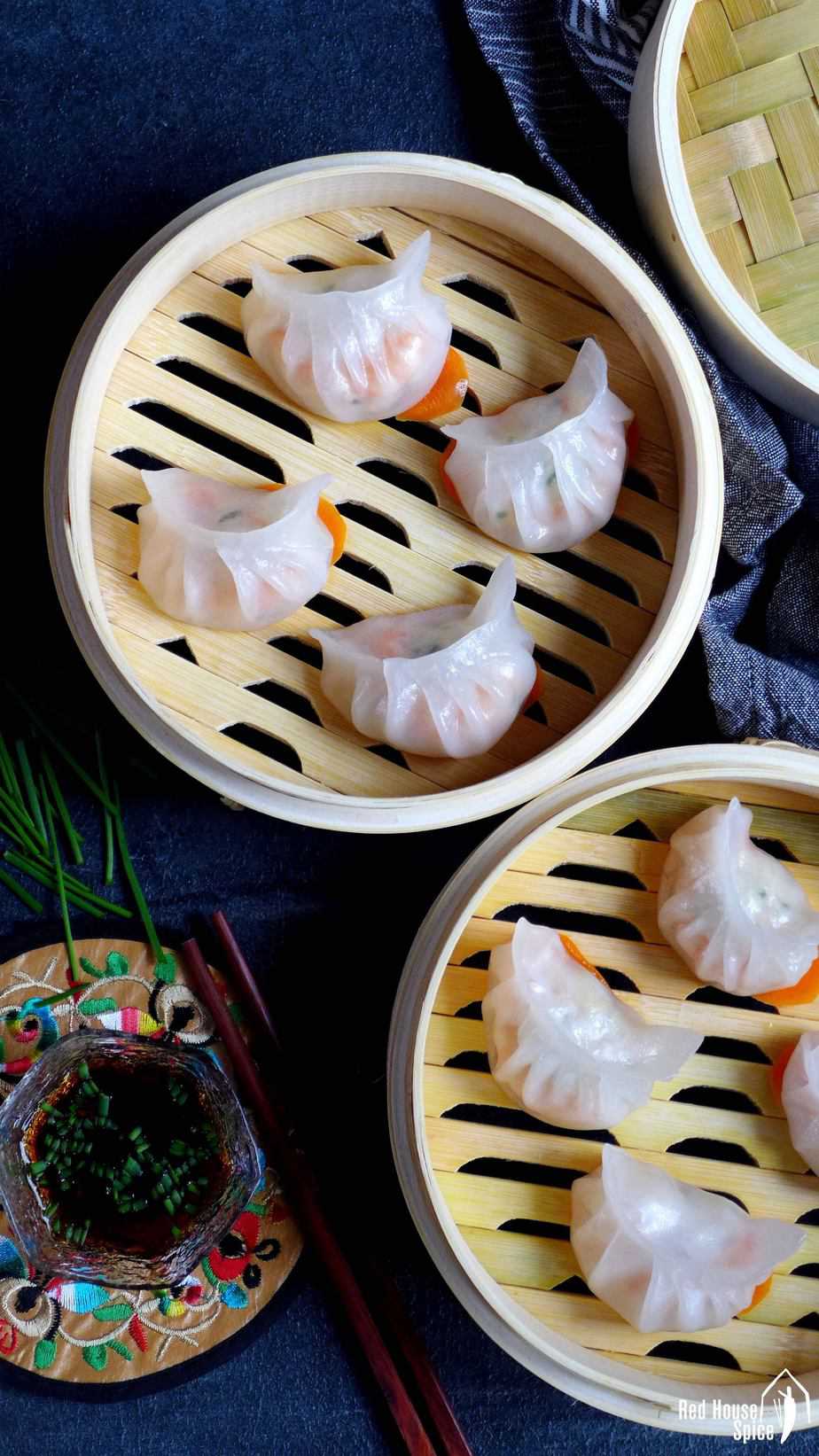
Having made Snow skin mooncakes following my recipe, one of my readers asked me: “Is there any other classic Chinese dishes I can make to use up the leftover wheat starch?” Of course! She reminded me of a wonderful dim sum dish that I always enjoy eating (as well as making). It’s called Har Gow (虾饺, crystal shrimp dumplings), a classic Cantonese dish that you can find in any dim sum restaurants.
Make the perfect dough for Har Gow
The unusual, translucent skin of Har Gow makes it stand out among the Chinese dumpling family. This is why, on many menus, Har Gow is also named “crystal shrimp dumpling (水晶虾饺)”. It’s not difficult at all to make the dough. However, the procedure can easily go wrong if you don’t follow a reliable recipe.
The ideal ratio of the key ingredients
The main ingredients are wheat starch, tapioca starch (can be replaced by cornstarch/potato starch) and water. Through experiments, I found the ideal ratio is 1:1:1. That is to say, these three ingredients share equal volume (Attention: NOT equal weight).
Make sure you use boiling water
Make sure that you pour BOILING water onto the starch mixture. I mean the water that has just been boiled (This is why I don’t use the term “hot water”). Otherwise, you could end up with a bowl of white liquid. That would be a complete disaster (It happened to me once so I know the pain).
Use the dough immediately
When a smooth, soft, slightly elastic dough appears, you can start wrapping the dumplings straight away (unlike regular flour dough that needs to rest for a while). In fact, if you leave the dough too long, its texture will change and thus won’t be workable.
Keep the Har Gow filling tasty & juicy
The filling is the soul of all dumplings. It needs to be flavoursome and moist. Har Gow is no exception.
- The use of water chestnuts and bamboo shoots not only gives the filling a crunchy texture, but they also add a nutty flavour.
- Sesame oil also makes a nice addition. However, excessive usage will overpower the taste of other key ingredients.
- Ginger is there to minimize the fishy flavour. Chive provides a mild oniony taste (You may skip it but do not replace it with spring onion whose taste is too strong for this recipe).
- A bit of lard (or regular cooking oil if you wish) is the key to a juicy filling. And don’t forget to add a bit of starch which keeps the prawn tender.
Put a whole shrimp in each dumpling
I suggest that you mince only half of the shrimp and wrap a whole shrimp in each dumpling (along with some minced filling).
This is my personal preference. When I had my first dim sum meal in a reputable Cantonese restaurant in Beijing years ago, I fell in love with Har Gow at first bite. I really enjoyed the sense of satisfaction given by a whole shrimp inside the dumpling. Another benefit is that the lovely pink colour of the whole shrimp can be seen through the translucent skin. More appetizing this way, isn’t it?
Use a cleaver if you have one
When making Har Gow, the traditional Chinese cleaver comes in handy. Use it if you have one. It will make things easy and it is indeed the authentic technique.
- When shaping the wrappers: Put a ball of dough underneath the side of a cleaver. Press while moving side to side. This way the wrapper can be made very thin and even all around. An important tip: coat the cleaver (and the work surface) with a thin layer of oil to avoid sticking.
- When making the filling: instead of chopping, crush the shrimp under the side of a cleaver by pressing hard with your hand. Give the crushed flesh a quick chop in the end.
However, you don’t need to invest on a cleaver for the sake of making Har Gow. Please feel free to use a regular knife to chop the shrimp and a rolling pin to shape the wrappers.
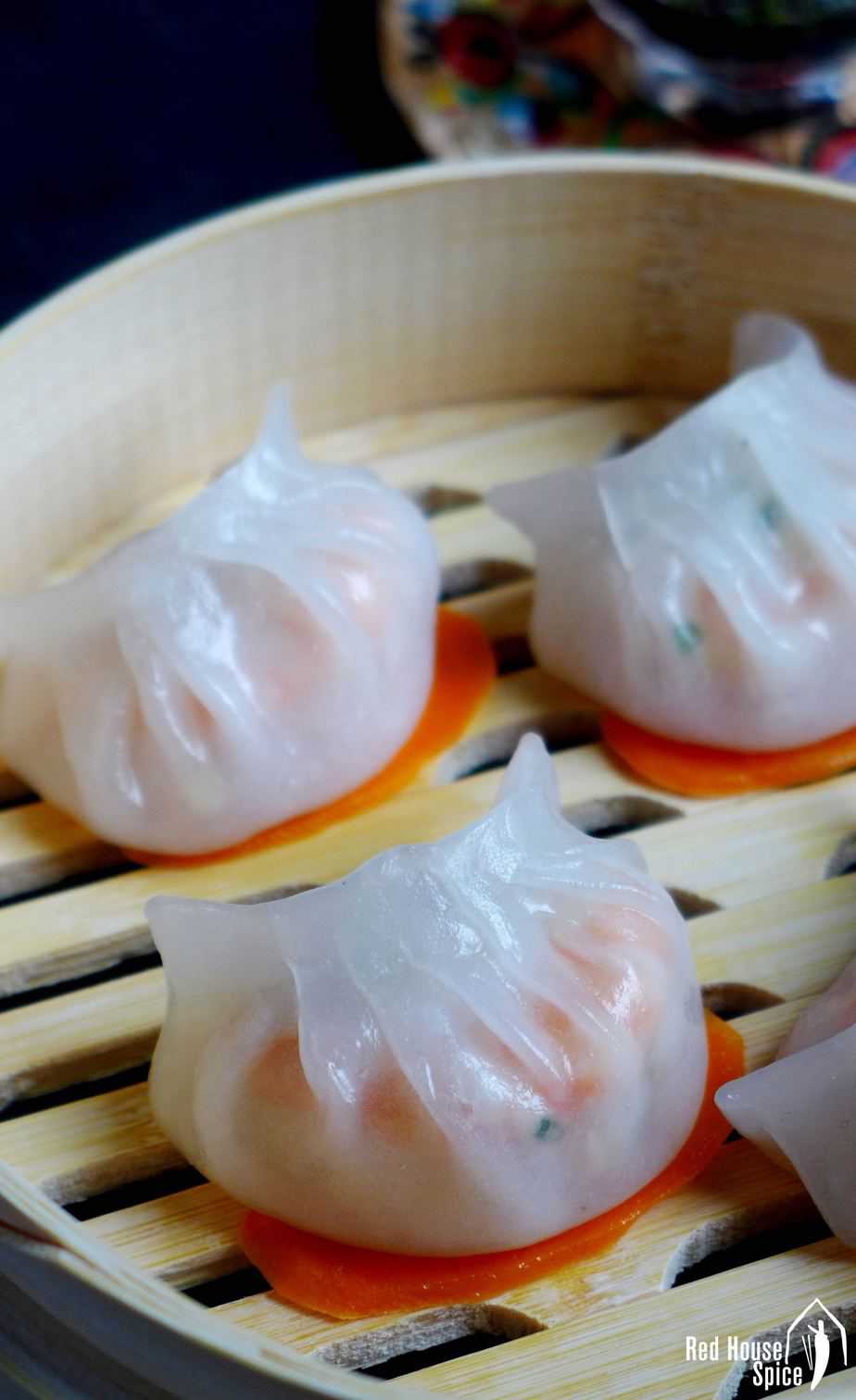
Dive deep into the world of dumplings
If you are a fan of Chinese dumplings, don’t forget to check out my Ultimate Dumpling Guide which includes all aspects of dumpling making:

Har gow: crystal shrimp dumplings (虾饺)
Ingredients
For the filling
- 200 g medium-sized shrimp, peeled and deveined - 7oz
- 3 tablespoon water chestnuts - minced
- 4 tablespoon bamboo shoots - minced
- 1 teaspoon ginger - minced
- 1 tablespoon fresh chive - finely chopped
- 1 teaspoon tapioca starch/cornstarch/potato starch
- 1 teaspoon lard - or cooking oil
- ½ teaspoon pure sesame oil
- ¼ teaspoon salt
- 1 pinch sugar
- 1 pinch white pepper
For the wrapper
- 40 g wheat starch - ⅓ cup
- 40 g tapioca starch/cornstarch/potato starch - ⅓ cup
- 1 pinch salt
- 1 teaspoon lard - or cooking oil
- 80 ml boiling water - ⅓ cup
You also need:
- 12 slices carrot - diagonally cut
Instructions
Prepare the filling
- Pick out 12 shrimp and set aside. Crush the rest of the shrimp by pressing them under the side of a cleaver. Then chop further (use a knife to mince the shrimp if you don't have a cleaver).
- In a mixing bowl, combine whole shrimp, minced shrimp and all the other ingredients for the filling. Place in the fridge.
Make the dough
- Put wheat starch, tapioca starch(or cornstarch/potato starch), salt and lard (or cooking oil) into a mixing bowl.
- Pour in water that has just been boiled (water at lower temptation will result in failure).
- Stir well with a pair of chopsticks, then knead with hands into a smooth, soft dough.
Shape the wrapper
- Make a loop with the dough. Divide it into 12 equal pieces.
- Lightly coat the working surface and the cleaver with oil.
- Roll one piece of dough into a ball. Press it with the side of the cleaver while moving side to side to make a very thin wrapper.
- Gently peel it off the cleaver (you may use a rolling pin to achieve this if you wish). Repeat to make the other wrappers.
Assemble the dumplings
- Place a spoonful of filling in the middle of a wrapper (including one whole shrimp).
- Hold with both hands. Pleat the far side of the wrapper by pressing with the index finger of one hand.
- Push the near side of the wrapper forward with the thumb of the other hand. Seal all around to make a crescent shape.
Steam the dumplings
- Heat up water in the pot on which you are going to place the steamer basket.
- Scatter carrot slices in the basket, then place dumplings on top of each slice (this is to avoid sticking).
- Place the basket in when the water is boiling. Cook with lid on over medium heat for 6 minutes (do not overcook).
Serve
- Leave the dumplings to cool a bit before gently removing them to serve (very hot dumpling skin tends to stick). You may dip them in a vinegary sauce if you wish.
Store
- Keep uncooked dumplings in the freezer for up to 4 weeks. No need to defrost when steaming.
- Put them in a steamer filled with cold water (different from the instructions for fresh dumplings). Cook for 8 minutes after the water starts to boil.
NUTRITION
NUTRITION DISCLOSURE: Nutritional information on this website is provided as a courtesy to readers. It should be considered estimates. Please use your own brand nutritional values or your preferred nutrition calculator to double check against our estimates.


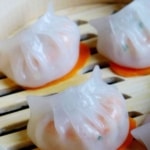

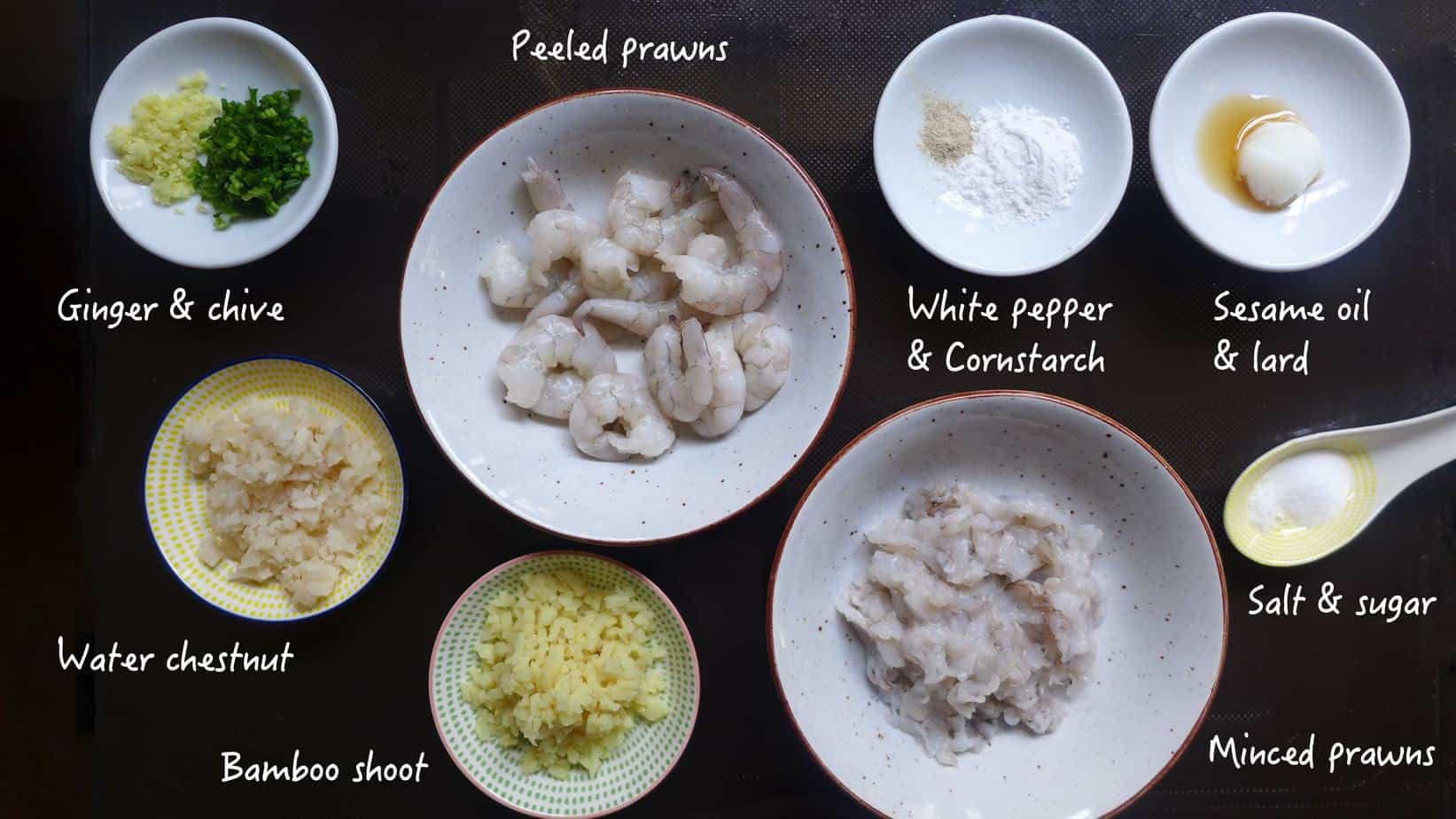
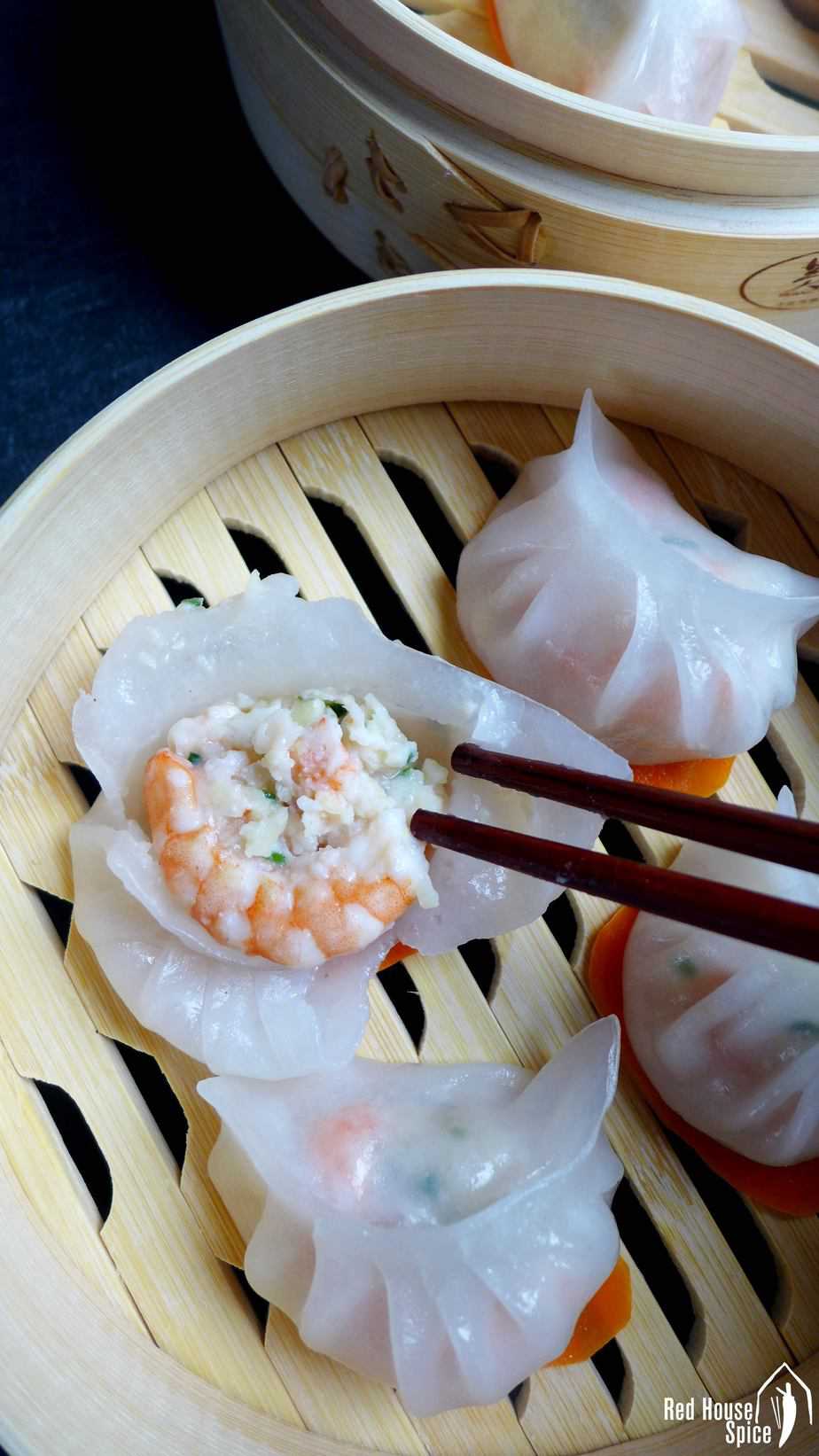






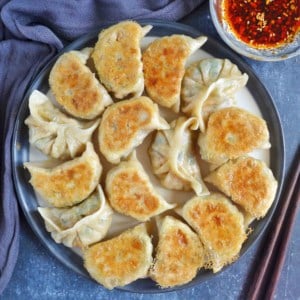
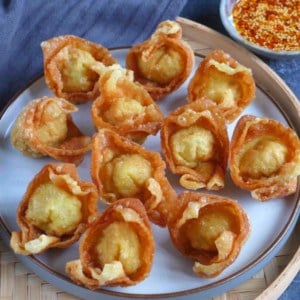
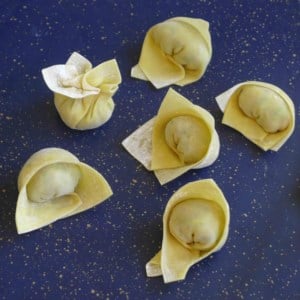
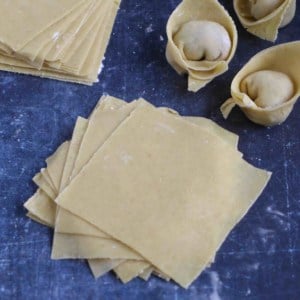
This is my third time trying to get the wrappers to roll out without breaking up – followed your instructions perfectly – think it ‘s the difference between NZ wheaten cornstarch and maybe Asian wheaten cornstarch ..can’t think of anything else ( did boiling water & oiled everything) – you didn’t say if rolling
the dough out was on oiled or floured surface
Sorry to hear that Mary. This recipe calls for regular cornstarch which is made from corn (btw it doesn’t have to be bought from Asian shops). I’ve never used wheaten cornstarch so I’m not sure if that is the cause of your problem. The dough should be soft and very easy to work with (That’s why you could use a cleaver to make the wrappers). If your wrappers break, it might be that the dough is a little too dry (could be caused by the type of cornstarch you use). Add a little water to make it softer. In the instruction section under “shape the wrapper”, I have mentioned that “Lightly coat the working surface and the cleaver with oil.” Hope this helps!
Thank you for this wonderful recipe!!! Do you think it would be an issue to put the dumplings together the day before cooking, keeping them in the fridge for about 24 hours? Thanks!
Hi Veronica! I wouldn’t suggest you leave uncooked dumplings for that long as the moisture from the filling will wet the wrappers. The alternative way is to store cooked dumplings in an airtight container (once they’re completely cool) in the fridge. Steam for a few minute to reheat when you’re ready to serve.
Hi Wei! I am gonna do a different filling so I want to add a handful of spring onions, finely chopped. My question is : can I add them strait from the freezer (since I always keep some there, in case I crave for Chinese :)? Or will it be too watery and ruin the dough?
Thank you!
Hi Simo! It’s ok to add frozen spring onion directly into the filling. Make sure you mix it with other ingredients very well and steam the dumplings right after assembly (don’t leave them on the counter for too long).
Hi Wei, I hope you are keeping well. I just made some Har Gow following your recipe, and they tasted amazing – I am preparing a dumpling only dinner for Saturday so cooking 1 type of dumpling every day, so I get to taste a few of them every day and freeze the rest 🙂 By the way, I made your pumpkin mochi yesterday and they were FANTASTIC. I have a quick question for you regarding the Har Gow. The shape didn’t hold very well after steaming the dumpling. I used a rolling pin to make the thin wrappers (and used a cookie cutter to get the round shape). I managed to shape them as per your recipe (half moon, some more beautiful than others, if I can be honest 😉 but when steaming them, they kind of lost the shape – they relaxed in the bamboo steamer. Can you think of any reason why they wouldn’t hold the shape? Thanks a lot!
Thank you Ivan for trying out my recipes! There could be two things that caused your problem: 1. The wrappers were a little too thin; 2. The wrappers didn’t hold the filling tightly enough (too much air trapped inside). Hope this helps.
Hi Wei, I have some frozen and my husband wants to take these to work (no stove), could I steam them in the microwave?
Do you mean uncooked frozen ones? I’ve never used microwave to steam them so I’m not sure if it will work. If you mean reheating cooked ones, microwave would do the trick. Sprinkle a little water over the dumplings. Loosely cover with a lid to heat.
I tried this and everything worked fine, up until the shaping of the dumplings.
I could not get them to stick together at the top, so in the end I decided to push the filling into the middle and roll them into a ball.
The whole idea of this is counter-intuitive for a person used to baking with dough, which I discovered by chance. My first thought with sticky dough is to flour everything, but I discovered that the opposite really worked. Wet the table, wet your hands, wet the rolling pin and then everything becomes far more workable.
I may try again when I have the patience, but they tasted lovely.
Thank you for sharing your experience and tricks!
I didn’t have the wheat starch, and we’re in lockdown so I subbed with cornstarch, the water was boiled but it turned into a white liquid, oops! I actually ended up microwaving in 15sec intervals and stirring inbetween till it went from stick gloop to soft and doughy, I then kneaded the lumps out and the end result was a nice pliable dumpling wrapper! I think I tried another recipe with my sister once and it was an epic fail as the dough just fell apart, so glad I found this recipe!
Amazing that you’ve fixed the dough by heating it up in a microwave. Clever!
Hi there! I’m super intrigued and would love to try this recipe but unfortunately I can’t find wheat starch in my area. Can I substitute potatoes starch or tapioca starch for the dough? Thanks for any tips!
Hi Fiona! Wheat starch is the key ingredient for this type of wrappers so I don’t recommend you replace it with other starch. If you can’t find it from local Chinese/Asian shops, try searching online. Good luck!
Hello Wei-Lǎoshī
I really enjoy cooking at home. I saw bamboo steaming baskets in a local charity shop and had to add them to my arsenal. I am not very experienced in Asian cooking but do love the food, style and culture.
I was very pleased to read through and watch some of the videos as they will help a lot with my endeavors to improve in the delicacies of Asian food.
I have always wanted to try dim sum dumplins and have yet to do so but look forward to trying. I was especially happy to see the use of carrots to prevent sticking. I always wondered what would be best.
I have to ask though, how to care for the baskets properly to prevent mould and splitting? Assuming oil but would like to know for certain.
Thank you so much for your efforts and sharing your work.
Russ.
My pleasure Russ! I don’t have a particular care routine for bamboo steamer baskets. I just simply hand wash them then air dry completely before storing in the cupboard. My current baskets have been used for 5+ years and have never had any problem. Wish you a great time exploring Asian cuisine!
Really liked the way you explained the recipe. It’s the little tips and explanations that are most important and you shared these so well.
Thanks
Very happy that you find my recipe helpful! I know how difficult it can if you aren’t familiar with a particular cooking method so I try my best to provide as much information as I can think of.